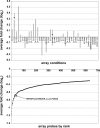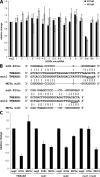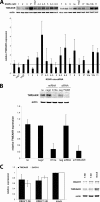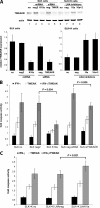Regulation of tumor necrosis factor-like weak inducer of apoptosis receptor protein (TWEAKR) expression by Kaposi's sarcoma-associated herpesvirus microRNA prevents TWEAK-induced apoptosis and inflammatory cytokine expression
- PMID: 20844036
- PMCID: PMC2976403
- DOI: 10.1128/JVI.00884-10
Regulation of tumor necrosis factor-like weak inducer of apoptosis receptor protein (TWEAKR) expression by Kaposi's sarcoma-associated herpesvirus microRNA prevents TWEAK-induced apoptosis and inflammatory cytokine expression
Abstract
Kaposi's sarcoma (KS)-associated herpesvirus (KSHV) is the causative agent of KS, the second most common AIDS-associated malignancy. KSHV expresses at least 18 different mature microRNAs (miRNAs) during latency. To identify cellular targets of KSHV miRNAs, we have analyzed a previously reported series of microarrays examining changes in cellular gene expression in the presence of KSHV miRNAs. Tumor necrosis factor (TNF)-like weak inducer of apoptosis (TWEAK) receptor (TWEAKR) was among the most consistently and robustly downregulated genes in the presence of KSHV miR-K12-10a (miR-K10a). Results from luciferase assays with reporter plasmids containing the 3' untranslated region (UTR) of TWEAKR suggest a targeting of TWEAKR by miR-K10a. The mutation of two predicted miR-K10a recognition sites within the 3' UTR of TWEAKR completely disrupts inhibition by miR-K10a. The expression of TWEAKR was downregulated in cells transfected with miR-K10a as well as during de novo KSHV infection. In a KS tumor-derived endothelial cell line, the downregulation of TWEAKR by miR-K10a resulted in reduced levels of TWEAK-induced caspase activation. In addition, cells transfected with miR-K10a showed less induction of apoptosis by annexin V staining and terminal deoxynucleotidyltransferase-mediated dUTP-biotin nick end labeling (TUNEL) assays. Finally, the downregulation of TWEAKR by miR-K10a in primary human endothelial cells resulted in a decrease in levels of expression of the proinflammatory cytokines interleukin-8 (IL-8) and monocyte chemoattractant protein 1 (MCP-1) in response to TWEAK. These results identify and validate an important cellular target of KSHV miRNAs. Furthermore, we demonstrate that a viral miRNA protects cells from apoptosis and suppresses a proinflammatory response, which may have significant implications in the complex context of KS lesions.
Figures






Similar articles
-
Kaposi's sarcoma-associated herpesvirus microRNAs repress breakpoint cluster region protein expression, enhance Rac1 activity, and increase in vitro angiogenesis.J Virol. 2015 Apr;89(8):4249-61. doi: 10.1128/JVI.03687-14. Epub 2015 Jan 28. J Virol. 2015. PMID: 25631082 Free PMC article.
-
Kaposi's sarcoma-associated herpesvirus microRNAs target IRAK1 and MYD88, two components of the toll-like receptor/interleukin-1R signaling cascade, to reduce inflammatory-cytokine expression.J Virol. 2012 Nov;86(21):11663-74. doi: 10.1128/JVI.01147-12. Epub 2012 Aug 15. J Virol. 2012. PMID: 22896623 Free PMC article.
-
Kaposi's Sarcoma-Associated Herpesvirus MicroRNAs Target GADD45B To Protect Infected Cells from Cell Cycle Arrest and Apoptosis.J Virol. 2017 Jan 18;91(3):e02045-16. doi: 10.1128/JVI.02045-16. Print 2017 Feb 1. J Virol. 2017. PMID: 27852859 Free PMC article.
-
TWEAK, a member of the TNF superfamily, is a multifunctional cytokine that binds the TweakR/Fn14 receptor.Cytokine Growth Factor Rev. 2003 Jun-Aug;14(3-4):241-9. doi: 10.1016/s1359-6101(03)00019-4. Cytokine Growth Factor Rev. 2003. PMID: 12787562 Review.
-
KSHV microRNAs: Tricks of the Devil.Trends Microbiol. 2017 Aug;25(8):648-661. doi: 10.1016/j.tim.2017.02.002. Epub 2017 Mar 2. Trends Microbiol. 2017. PMID: 28259385 Free PMC article. Review.
Cited by
-
Clinical Manifestations of Kaposi Sarcoma Herpesvirus Lytic Activation: Multicentric Castleman Disease (KSHV-MCD) and the KSHV Inflammatory Cytokine Syndrome.Front Microbiol. 2012 Mar 2;3:73. doi: 10.3389/fmicb.2012.00073. eCollection 2012. Front Microbiol. 2012. PMID: 22403576 Free PMC article.
-
A Kaposi's sarcoma-associated herpesvirus microRNA and its variants target the transforming growth factor β pathway to promote cell survival.J Virol. 2012 Nov;86(21):11698-711. doi: 10.1128/JVI.06855-11. Epub 2012 Aug 22. J Virol. 2012. PMID: 22915806 Free PMC article.
-
Ago HITS-CLIP expands understanding of Kaposi's sarcoma-associated herpesvirus miRNA function in primary effusion lymphomas.PLoS Pathog. 2012;8(8):e1002884. doi: 10.1371/journal.ppat.1002884. Epub 2012 Aug 23. PLoS Pathog. 2012. PMID: 22927820 Free PMC article.
-
Sequence analysis of Kaposi sarcoma-associated herpesvirus (KSHV) microRNAs in patients with multicentric Castleman disease and KSHV-associated inflammatory cytokine syndrome.J Infect Dis. 2012 Jun;205(11):1665-76. doi: 10.1093/infdis/jis249. Epub 2012 Mar 23. J Infect Dis. 2012. PMID: 22448005 Free PMC article.
-
A Cell's Fate: An Overview of the Molecular Biology and Genetics of Apoptosis.Int J Mol Sci. 2019 Aug 24;20(17):4133. doi: 10.3390/ijms20174133. Int J Mol Sci. 2019. PMID: 31450613 Free PMC article. Review.
References
-
- Almstrup, K., C. E. Hoei-Hansen, U. Wirkner, J. Blake, C. Schwager, W. Ansorge, J. E. Nielsen, N. E. Skakkebaek, E. Rajpert-De Meyts, and H. Leffers. 2004. Embryonic stem cell-like features of testicular carcinoma in situ revealed by genome-wide gene expression profiling. Cancer Res. 64:4736-4743. - PubMed
-
- Burkly, L. C., J. S. Michaelson, K. Hahm, A. Jakubowski, and T. S. Zheng. 2007. TWEAKing tissue remodeling by a multifunctional cytokine: role of TWEAK/Fn14 pathway in health and disease. Cytokine 40:1-16. - PubMed
-
- Caselli, E., S. Fiorentini, C. Amici, D. Di Luca, A. Caruso, and M. G. Santoro. 2007. Human herpesvirus 8 acute infection of endothelial cells induces monocyte chemoattractant protein 1-dependent capillary-like structure formation: role of the IKK/NF-kappaB pathway. Blood 109:2718-2726. - PubMed
Publication types
MeSH terms
Substances
Grants and funding
LinkOut - more resources
Full Text Sources
Molecular Biology Databases
Research Materials
Miscellaneous

